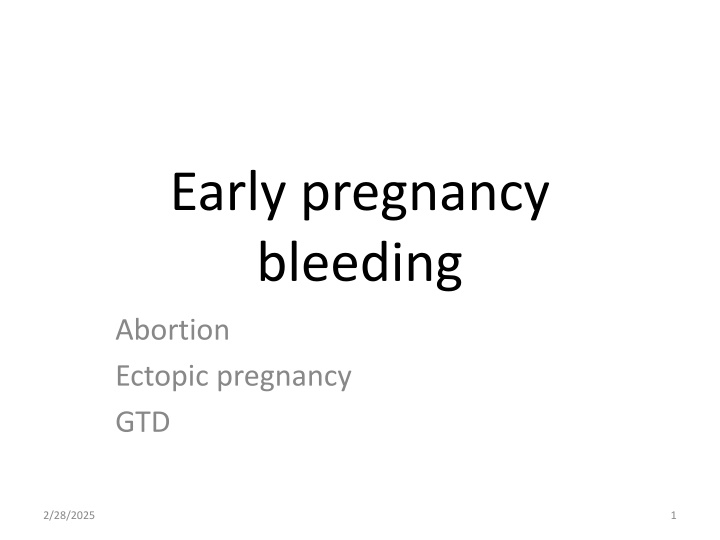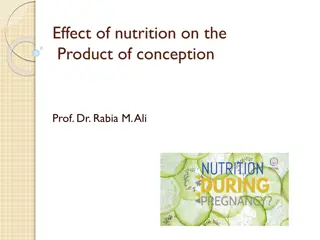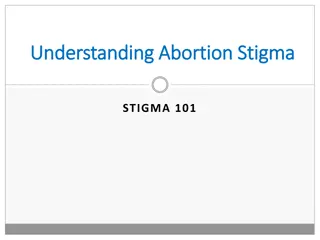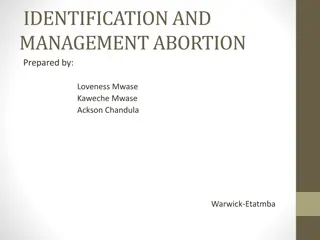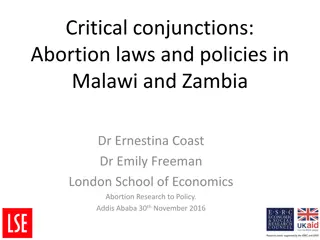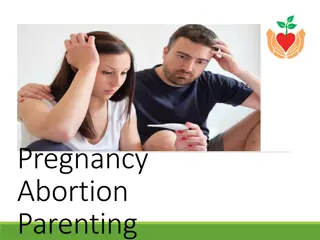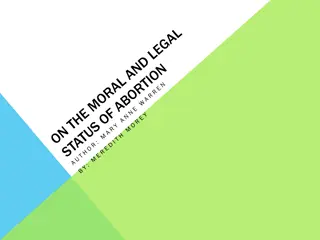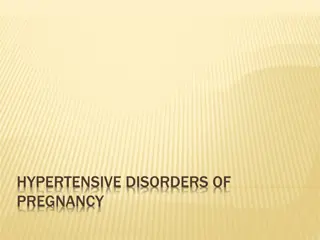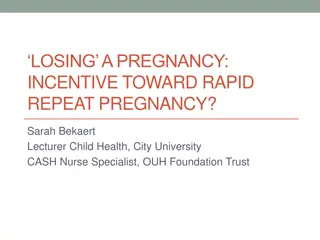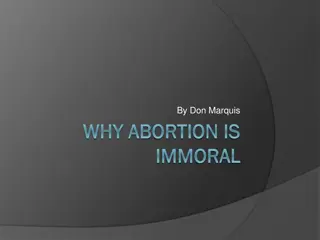Abortion in Early Pregnancy: Definition, Etiology, and Management
Definition, causes, and management of abortion in early pregnancy, including classification, diagnosis, and post-abortion care. Learn about first and second trimester etiologies, unexplained abortion, and classifications based on clinical presentation and gestational age.
Download Presentation

Please find below an Image/Link to download the presentation.
The content on the website is provided AS IS for your information and personal use only. It may not be sold, licensed, or shared on other websites without obtaining consent from the author.If you encounter any issues during the download, it is possible that the publisher has removed the file from their server.
You are allowed to download the files provided on this website for personal or commercial use, subject to the condition that they are used lawfully. All files are the property of their respective owners.
The content on the website is provided AS IS for your information and personal use only. It may not be sold, licensed, or shared on other websites without obtaining consent from the author.
E N D
Presentation Transcript
Early pregnancy bleeding Abortion Ectopic pregnancy GTD 2/28/2025 1
1.Abortion Outlines Definition Etiology Classification Diagnosis Management 2/28/2025 2
By the end of the lesson the student should be able to 1. Define Abortion 2. Describe the ethologic of abortion 3. Describe the management of abortion 4. List post abortion cares 2/28/2025 3
Abortion Definition -is Loss of pregnancy before viability: - spontaneously - induced It implies the process of expulsion or extraction of products of conception Viability: - 20 wk, 24wk, 28 wk - 500gm, 1000gm Ethiopian context is 28 wk or 1000 gm 2/28/2025 4
Etiology A. First trimester abortion :(the first 12 wk) 1. Fetal chromosomal abnormalities - particularly Trisomy, 2 . Anembryonic pregnancy - Blighted ovum 3. Parental balanced translocation 4. Infections: genital tract infection , systemic infection with pyrexia & ToRCH syndrome 5. Endocrine disorders : Diabetes, hypothyroidism , PCOS & Corpus luteum insufficiency,erythroblastosis fetais 6. Uterine disorders: Uterine anomalies , sub mucus fibroid & Asher man's syndrome 7. Thrombophilia 8. Immunological disorders 9. Cigarette smoking ,alcohol, anaesthetic agents & chemical agents . 10. Psychological disorders 2/28/2025 5
Etiology B. Second trimester abortion: 1. Multiple pregnancy 2. Cervical incompetence (congenital & acquired ) 3. Uterine anomalies and sub mucous fibroid 4. Genital tract infection and PROM 5. Systemic infections: HIV, Malaria, syphilis, Rubella 6. Maternal health: Diabetes, Renal disease, Hypertension 2/28/2025 6
Unexplained Abortion Unexplained: The etiology of spontaneous abortion of chromosomally and structurally normal embryos/fetuses in apparently healthy women is unclear. 2/28/2025 7
Classification of abortion A. Clinically: 1. Threatened abortion 2. Inevitable abortion 3. Incomplete abortion 4. Complete abortion 5. Missed abortion 6. Septic abortion 7. Recurrent abortion 2/28/2025 8
Classification B. Gestational Age: 1. Fist trimester 2. Second trimester C. Method 1. Spontaneous 2. Induced 2/28/2025 9
Differential diagnosis Ectopic pregnancy Molar pregnancy AUB other than Pregnancy Local causes like cervicitis Urinary tract, GI tract bleeding 2/28/2025 10
Threatened abortion 1. History Mild vaginal bleeding. No or mild abdominal pain 2. Examination Good general condition. The cervix is closed The uterus is usually the correct size for date 3. U/S which is essential for the diagnosis Showed the presence of fetal heart activity. 2/28/2025 11
Threatened abortion (Management) 1. ReassuranceIf fetal heart activity is present, > 90% of cases will be progressed satisfactorily 2. Advice: Decrease physical activity (bed rest is of no therapeutic value), avoid intercourse. 3. Hormones i.e. Progesterone & hCG Which are used in the first trimester to support pregnancy 4. Anti- D:An adequate dose of 5. ANC as high risk patients 2/28/2025 12
Inevitable danforth and Incomplete abortions-read 1. History Heavy vaginal bleeding. with no passage of products conception (inevitable) with the passage of products of conception (incomplete abortion) Severe lower abdominal pain which follows the bleeding (both) 2/28/2025 13
Inevitable and Incomplete 2. Examinations Poor general condition. The cervix is dilating and products of conception may be passing trough the os The uterus may be the correct size for date (inevitable abortion) or small for date (incomplete abortion) 3. U/S Fetal heart activity may or may not present in inevitable abortion or retained products of conception ( RPOC ) in incomplete abortion 2/28/2025 14
Inevitable (Management) and incomplete abortions 1. CBC , blood grouping , Blood 2. Resuscitation large IV line, fluids & blood transfusion 3. Oxytoxic drugs 4. Evacuation & curettage 5. Give anti D in the same way like threatened abortion 6. Post-abortion management. 2/28/2025 15
Complete abortion 1. History Heavy vaginal bleeding which has been stopped. lower abdominal pain which follows the bleeding which has been stopped. 2. Examination Initially cervix closed but later 3. U/S showed empty uterine cavity or PROP 2/28/2025 16
Complete abortion (Management) 1. Confirm it is complete by U/S 2. Post-abortion care 2/28/2025 17
Missed abortion A missed abortion refers to in-utero death of the embryo or fetus prior to the 20th/28th week of gestation, with retention of the pregnancy for a prolonged period of time.(1 wk and above) NB- IUFD is inutero death of fetus of >=28 GA 2/28/2025 18
Missed abortion 1. Most of missed abortions are diagnosed accidentally during routine U/S in early pregnancy . In some cases there may be a history of : Episodes of mild vaginal bleeding Regression of early symptoms of pregnancy . Stop of fetal movements after 20 weeks gestation. 2. Examination The uterus may be small for date 2/28/2025 19
Missed abortion 3. U/S (which is essential for diagnosis ) diagnosed if two ultrasound ( T/V or T/A) at least 7days apart showed an embryo of > 7 weeks gestation ( CRL > 6mm in diameter and gestational sac > 20 mm in diameter ) with no evidence of heart activity . 2/28/2025 20
No fetal cardiac activity 2/28/2025 21
Missed abortion (Management) 1. CBC , blood grouping , units of blood 2. Platelets count, PT, PTT to exclude the risk of DIC - magt- D &c 2/28/2025 22
Anembryonic pregnancy (Blighted ovum) It is due to an early death and resorption of the embryo with the persistence of the placental tissue. It is diagnosed if two ultrasound ( T/V or T/A) at least 7 days apart showed after 7 weeks of gestation (i.e. gestational sac > 20mm ) an empty gestational sac with no fetal echoes seen . It is treated in a similar way to missed abortion . 2/28/2025 23
Blighted ovum Anembryonic pregnancy Empty gestational sac 2/28/2025 24
Septic abortion Definition : Commonly it is an incomplete abortion which complicated by infection of the uterine contents . It can be any clinical variety: Induced, Spontaneous, Incomplete. Inevitable, Complete, missed abortions. Features : Poor general condition Include the features of incomplete abortion i.e. severe vaginal bleeding with passage of product of conception, with or without history of evacuation. Features of pelvic infection i.e. pyrexia , tachycardia , general malaise , lower abdominal pain , pelvic tenderness & purulent vaginal discharge . 2/28/2025 25
Septic abortion Bacteriology : Mixed infection The commonest organisms are : 1. Gram -ve : E.coli , strepto & staphylococcu 2. Anaerobics : Bacteroides These organisms indicate that the infection is ascending from vaginal flora Rarely Cl. tetani , which is potentially lethal if not treated adequately . Types : Mild the infection is confined to decidua or endometrium : 80% Moderate the infection extended to myometrium15% Severe the infection extended to pelvis + Endotoxic shock + DIC 5% 2/28/2025 26
Septic abortion Management : 1. Investigations : CBC , blood grouping , 2 units of blood . Coagulation profile , serum electrolytes & blood culture if pyrexia > 38.5 C 2. Antibiotics 3. Surgical evacuation of) 4. Post-abortion management. 2/28/2025 27
Complications of abortion 1. 2. Hemorrhage . Complication related to surgical evacuation ie E&C and D&C. Uterine perforation- which may lead to rupture uterusin the subsequent pregnancy. Cervical tear &excessive cervical dilatation which may lead to cervical incompetence. Infection which may lead to infertility & Asher man's syndrome. Excessive curettage which may lead to Adenomyosis Rh- iso immunization Psychological trauma . 3. 4. 2/28/2025 28
Post - abortion management In cases of incomplete, inevitable, complete, missed & septic abortions 1. Support: from the husband, family& obstetric staff 1. Anti D to all Rh ve, nonimmunised patients, whose husbands are Rh+ve 3. Counseling & explanation: A. Contraception (Hormonal, IUCD, Barrier) Should start immediately after abortion if the patient choose to wait , because ovulation can occur 14 days after abortion and so pregnancy can occur before the expected next period . 2/28/2025 29
PAC(post Abortion care) : Five elements 1. Emergency treatment of incomplete abortion and its complications 2. Counseling- about procedure, post procedure cxn prevention, when to seek care etc 3. FP services 4. Linkage with other RH services 5. Community-service provider partnership (community awareness creation on safe abortion methods) 2/28/2025 30
Recurrent abortion Definition : Is defined as 3 or more consecutive spontaneous abortions It may presented clinically as any of other types of abortions . Types : Primary : All pregnancies have ended in loss Secondary : One pregnancy or more has proceeded to viability(>24 weeks gestation) with all others ending in loss Incidence : occurs in about 1% of women of reproductive age . 2/28/2025 31
Recurrent abortion Causes Idiopathic recurrent abortion, in about 50%, in which no cause can be found . The known causes include the followings : 1. Chromosomal disorders: Fetal chromosomal abnormalities & structural abnormalities Parental balanced translocation 2. Anatomical disorders: Cervical incompetence: congenital and acquired Uterine causes: sub mucous fibroids, uterine anomalies & Asher man's syndrome 2/28/2025 32
Recurrent abortion Causes 3. Medical disorder:s Endocrine disorders : diabetes , thyroid disorders , PCOS & corpus luteum insufficiency . Immunological disorders Thrombophilia: congenital deficiency of Protein C&S and antithrombin III, & presence of factor V leiden. Infections ToRCH - CMV may be a cause of recurrentabortion Genital tract infection e.g. Bacterial vaginosis Rh isoimmunization 2/28/2025 33
THANK YOU SO MUCH!!! 2/28/2025 34
2. Ectopic pregnancy Outlines Definition Risk factors Manifestations Diagnosis Management 2/28/2025 35
Ectopic Pregnancy Definition: Ectopic pregnancy is one in which the blastocyst implants anywhere other than the endometrial lining of the uterine cavity. Ectopic pregnancy accounted for 10 % of all pregnancy-related deaths Incidence Ectopic pregnancies occurred, at a rate of 16 ectopic pregnancies pregnancies (1.6%) More than 95 % ectopic pregnancy are tubal per 1,000 reported 2/28/2025 36
Various sites and frequency of ectopic pregnancies. 2/28/2025 37
Risk Factors An appreciation of risk factors for ectopic pregnancy leads to a more timely diagnosis with improved maternal survival and future reproductive potential. Prior ectopic pregnancy, documented tubal pathology, surgery to restore tubal patency, or tubal sterilization carry the highest risks of obstruction and subsequent ectopic pregnancy Risk factors for ectopic pregnancy can be divided into those that confer High Moderate, or Low/slight risk 2/28/2025 38
Risk factor for ectopic pregnancy Risk factor High Risk Tubal corrective surgery Tubal sterilization Previous ectopic pregnancy In utero DES exposure Intrauterine device Documented tubal pathology Moderate Risk Infertility Previous genital infection Multiple partners Slight Risk Previous pelvic or abdominal surgery 0.93 3.8 Smoking Douching Intercourse before 18 years Odds Ratio 21.0 9.3 8.3 5.6 4.2 45 3.8 21 2.5 21 2.5 3.7 2.1 2.3 2.5 1.1 3.1 1.6 2/28/2025 39
Risk Factors Contd. Cigarette smoking : o In the period increases the risk of ectopic pregnancy in a dose-dependent manner, thus it can be either a low or moderate risk factor depending on the patient's habits. o This may be the result of impaired immunity in smokers, thus predisposing them to pelvic inflammatory disease, or to impairment in tubal motility In vitro fertilization: o May be doe to impaired tubal motility from hormonal stimulation o Increased the incidence of "Atypical" implantation: Cornual, abdominal, cervical & ovarian 2/28/2025 40
Risk Factors Contd. Age > 40 years Myoelectrical propulsive activity in the fallopian tube. This activity facilitates movement of the sperm and ova toward each other and propels the zygote toward the uterine cavity. Aging results in progressive loss of myoelectrical activity along the fallopian tube, which may explain the increased incidence of tubal pregnancy in perimenopausal women . activity is responsible for 2/28/2025 41
Risk Factors Contd. Contraceptives Most forms of contraception will ironically increase the relative incidence of ectopic pregnancy by decreasing the number of intrauterine pregnancies. The relative number of ectopic pregnancies varies by contraceptive use. For example, barrier contraception and the TCu380A IUD do not confer an increased ectopic pregnancy rate . Hormonal control of the muscular activity in the fallopian tube may explain the increased incidence of tubal pregnancy associated with failures of the morning after pill, minipill, progesterone-containing intrauterine devices (IUDs), and ovulation induction. Tubal sterilization can be followed by an ectopic pregnancy. 2/28/2025 42
Clinical Manifestations Symptoms Triads occur in 50% of patients oAmenorrhea ovaginal bleeding oAbdominal pain on the affected side Other pregnancy discomforts such as breast tenderness, nausea, and urinary frequency may accompany more ominous findings. Shoulder pain Vertigo and syncope from hemorrhagic hypovolemia. Many women with a small unruptured ectopic pregnancy have unremarkable clinical findings. 2/28/2025 43
Clinical Manifestations Contd. Physical examination Vital Signs normal or deranged Abdominal and pelvic findings are notoriously scant in many women before tubal rupture. With rupture oPale oAcutely sick o Signs of fluid collection osigns of acute abdomen. oCervical motion tenderness oAdnexal mass oBuldged cul-de-sac 2/28/2025 44
Differential diagnosis Abortion GTD PID Corpus luteum cyst Cystitis Renal colic Adnexal cyst torsion Degenereting Mayoma Appendicitis Mesenteric lymph adenitis 2/28/2025 45
Diagnosis Clinical: high index of suspicion Laboratory tests: Hct Blood group & Rh Urine HCG Serum beta HCG Serum progesterone Ultrasound Culdocentesis Endometrial Sampling Diagnostic laparoscopy : Gold standard for diagnosis of ectopic pregnancy 2/28/2025 46
Algorithm for the diagnosis of ectopic pregnancy 2/28/2025 47
Management of ectopic pregnancy 1. Medical: Oral, parenteral or direct Injection into Ectopic Pregnancy Methotrexate Prostaglandins Mifepristone Potassium chloride - When a tubal pregnancy coexists with a uterine pregnancy, potassium chloride can be injected into the tubal pregnancy sac as methotrexate is c/I in the presence of intrauterine preg. Hyperosmolar glucose 2. Surgical 3. Expectant management 4. Anti D for Rh negative women 2/28/2025 48
Medical Treatment Protocols for Ectopic Pregnancy Single Dose Two dose Multidose(but max. is upto 4 dose) Dosing One dose; repeat if necessary Days 0 and 4 Up to 4 doses of both drugs until serum -HCG declines by 15% Medication Dosage 50 mg/m2 BSA (day 1) IM Methotrexate 50 mg/m2 BSA IM 1 mg/kg, days 1, 3, 5, and 7 Leucovorin N/A N/A 0.1 mg/kg days 2, 4, 6, and 8 Serum -HCG level Days 0 (baseline), 4, and 7 Days 0 (baseline),4, and 7 Days 11 and 14 if repeat dose is given Days 0 (baseline), 1, 3, 5, and 7 Indication for additional dose If serum -HCG declines <15%, give additional dose; repeat serum -HCG in 48 hours and compare with previous value; maximum four doses If serum -HCG level does not decline by 15% from day 4 to day 7 Less than 15% decline during weekly surveillance If serum -HCG does not decline by 15% from day 4 to day 7 If serum -HCG does not decline by 15% from day 7 to day 11 If the above occur Maximum of four doses is given Post therapy surveillance 2/28/2025 After dy 7 HCG measurement do Weekly measurement until serum -hCG undetectable Weekly until serum -HCG undetectable Weekly until serum -HCG undetectable 49
Prevention Tubal pathology carries one of the highest risks and pelvic inflammatory disease plays a major role in tubal adhesions and obstruction. Because chlamydial infections constitute nearly half of pelvic inflammatory disease cases, efforts have been directed towards screening high-risk populations for asymptomatic infections. These include sexually active women under the age of 25 or women who use non barrier forms of contraception. Such screening programs in Sweden have demonstrated steady declines in both chlamydial infections and ectopic pregnancy rates, especially in women aged 20 to 24 years 2/28/2025 50
